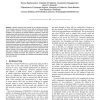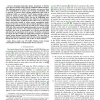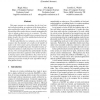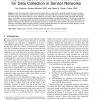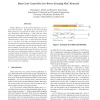189
click to vote
TMC
2010
14 years 7 months ago
2010
Wireless networks have evolved into an important technology for connecting users to the Internet. As the utility of wireless technology grows, wireless networks are being deployed ...
118
click to vote
TMC
2010
14 years 7 months ago
2010
Cooperation between wireless nodes to retransmit data for the other users introduces multiuser diversity to a wireless network and increases the system throughput. In this paper, t...
TMC
2010
14 years 7 months ago
2010
Although the EDCA access mechanism of the 802.11e standard supports legacy DCF stations, the presence of DCF stations in the WLAN jeopardizes the provisioning of the service guaran...
142
click to vote
TMC
2010
14 years 7 months ago
2010
Emerging dual-mode phones incorporate a Wireless LAN (WLAN) interface along with the traditional cellular interface. The additional benefits of the WLAN interface are, however, lik...
120
click to vote
TMC
2010
14 years 7 months ago
2010
The integration of different wireless access technologies combined with the huge characteristic diversity of supported services in next-generation wireless systems creates a real h...
TMC
2010
14 years 7 months ago
2010
137
click to vote
TMC
2010
14 years 7 months ago
2010
A data mule represents a mobile device that collects data in a sensor field by physically visiting the nodes in a sensor network. The data mule collects data when it is in the prox...
95
Voted
TMC
2010
14 years 10 months ago
2010
—Rate adaptation is a critical component that impacts the performance of IEEE 802.11 wireless networks. In congested networks, traditional rate adaptation algorithms have been sh...
110
click to vote
TMC
2010
14 years 10 months ago
2010
—This paper proposes a framework to maximize the lifetime the wireless sensor network (WSN) by using a mobile sink when the underlying applications tolerate delayed information d...
126
Voted
TMC
2010
14 years 10 months ago
2010
Energy efficiency is of the utmost importance in wireless sensor networks. The family of low-power-listening MAC protocols was proposed to reduce one form of energy dissipation�...
